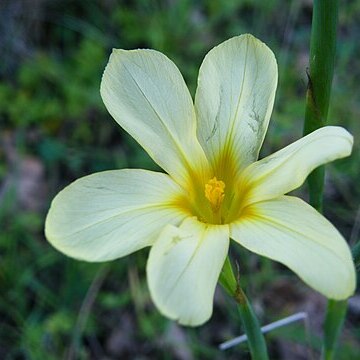Plants large, 300-600 mm high. Corm ± 20 mm diam.; tunics of hard, wiry, black fibres. Stem several-branched, slightly flexed above sheaths of foliage and sheathing leaves, these attenuate, 35-60 mm long. Foliage leaf solitary, usually inserted well above ground, linear, channelled, exceeding stem and trailing distally, 9-13 mm wide. Rhipidial spathes attenuate, inner 55-80 mm long, outer 1/2-2/3 as long. Flowers long-lived, salmon-pink or yellow with yellow cup, all tepal limbs with deep yellow nectar guide at bases, ± spreading, tepal claws diverging, forming wide cup ± 12 mm deep including filaments and bases of anthers; outer tepals ± oblong to obovoid, 35-40 x 13-20 mm, claws up to 14 mm long, smooth or minutely papillate in lower part, inner tepals slightly smaller than inner. Filaments 7-8 mm long, united in a column smooth to sparsely papillate-pubescent in lower half, widest at base, tapering slightly to apex; anthers 8-11 mm long, contiguous for 3 mm, slightly diverging distally, yellow; pollen yellow. Ovary cylindric, 17-20 mm long; style branches slightly diverging, up to 7 mm long, stigmas bilobed, curved upward above apex of anthers, crests ± 1 mm long, erect, triangular. Capsules cylindric, mostly 30-55 mm long, tapering near apex, with a distinct beak ± 2 mm long.
More
Herb 25–60 cm high. Corm c. 2 cm diam. Leaf solitary, inserted above ground level, longer than scape, 9–13 cm wide. Scape simple or with flexed branches; bracts 2–6 cm long. Outer spathe 3–4 cm long, inner 6–8 cm long. Flowers orange with yellow centre, rarely all yellow. Sepals and petals 2.7–4 cm long, the claws forming an open cup 1–2 cm diam.; sepals oblong, petals oblanceolate. Filaments connate in tube 6–8 mm long, glabrous, or puberulous below; anthers 6–11 mm long, parallel at base, divergent above. Ovary 1.5–2 cm long; style trifid 2–3 mm above base of anthers; branches ± divergent, 5–7 mm long; stigmas bilobed, held above anthers; style crests erect to incurved, triangular, c. 1 mm long. Capsule 2.5–5.5 cm long; beak acute, c. 2 mm long. [See also Green (1994: 516–517), as Homeria flaccida.]
Cormous geophyte, 35-60 cm, stem flexed outward above leaf sheath. Leaf solitary, linear, channelled. Flowers salmon with a yellow centre or entirely yellow, tepal claws forming a wide, shallow cup, anthers exserted on a thick filament column.
A serious weed of pastures, roadsides and disturbed ground, but never under dense tree or shrub cover; difficult to control and toxic to stock.

